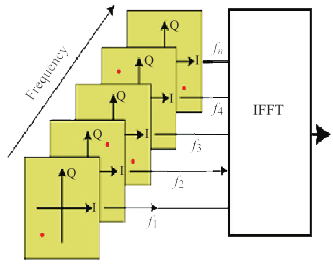Complexity of I and Q signals in OFDM and method of simpler decoding and error detection
DOI:
https://doi.org/10.3103/S0735272721120037Keywords:
OFDM, multicarrier modulation, I/Q signals, PSK modulation, Bit Error Rate (BER), IEEE 802.11 standardsAbstract
The modulation schemes in the IEEE 802.11 radio frequency communication protocols are based on two carriers at right angles, called I and Q signals. These two signals, which are formed for the data symbols, are further modulated at radio frequency on two main carriers, which have a phase shift of 90° to each other. The critical analysis of the methods for generating the I/Q signals is given here. The phase and amplitude imbalance errors caused by using two signals to decode one data element are shown. This scheme is used mainly together with the orthogonal frequency division multiplexing (OFDM), employing the Inverse Fourier Transform (IFFT) at the transmitter and direct Fast Fourier Transform (FFT) at the receiver. An alternative better method is described, which does not need to use IFFT and FFT. This method involves the sequential demodulation of subcarriers one by one, and finally the error prone subcarriers are ascertained. It is also feasible to employ this method for correcting the symbol errors.
References
- J. G. Proakis, M. Salehi, Communication Systems Engineering. New Jersey: Prentice Hall, 2002.
- M. Moher, S. Haykin, Communication Systems. Wiley, 2009.
- Cisco, 802.11 Wireless LAN Fundamentals. Cisco Press, 2003, uri: https://www.oreilly.com/library/view/80211-wireless-lan/1587050773/.
- M. A. Hannan, S. M. Abbas, S. A. Samad, A. Hussain, “Modulation techniques for biomedical implanted devices and their challenges,” Sensors, vol. 12, no. 1, pp. 297–319, 2011, doi: https://doi.org/10.3390/s120100297.
- S. B. Weinstein, “The history of orthogonal frequency-division multiplexing [History of Communications],” IEEE Commun. Mag., vol. 47, no. 11, pp. 26–35, 2009, doi: https://doi.org/10.1109/MCOM.2009.5307460.
- C. Microcircuits, “CMX973 – RF Quadrature Modulator/Demodulator.” https://www.cmlmicro.com/products/rf-quadrature-modulatordemodulator/.
- T. Hwang, C. Yang, G. Wu, S. Li, G. Ye Li, “OFDM and its wireless applications: a survey,” IEEE Trans. Veh. Technol., vol. 58, no. 4, pp. 1673–1694, 2009, doi: https://doi.org/10.1109/TVT.2008.2004555.
- B. Hirosaki, “An orthogonally multiplexed QAM system using the discrete Fourier transform,” IEEE Trans. Commun., vol. 29, no. 7, pp. 982–989, 1981, doi: https://doi.org/10.1109/TCOM.1981.1095093.
- Y. Wu, W. Y. Zou, “Orthogonal frequency division multiplexing: a multi-carrier modulation scheme,” IEEE Trans. Consum. Electron., vol. 41, no. 3, pp. 392–399, 1995, doi: https://doi.org/10.1109/30.468055.
- Y. Feng, Z. Teng, F. Meng, B. Qian, “An accurate modulation recognition method of QPSK signal,” Math. Probl. Eng., vol. 2015, pp. 1–7, 2015, doi: https://doi.org/10.1155/2015/516081.
- R. Keim, “Understanding quadrature phase shift keying (QPSK) modulation,” All about circuits, 2016.
- A. Mondragon-Torres, M. Kommi, T. Bhattacharya, “Orthogonal frequency division multiplexing (OFDM) development and teaching platform,” in 2011 ASEE Annual Conference & Exposition Proceedings, 2011, pp. 22.1130.1-22.1130.10, doi: https://doi.org/10.18260/1-2--18656.
- A. R. S. Bahai, B. R. Saltzberg, M. Ergen, Multi-Carrier Digital Communications: Theory and Applications of OFDM. New York: Springer, 2004.
- H. Steendam, M. Moeneclaey, H. Sari, “The effect of carrier phase jitter on the performance of orthogonal frequency-division multiple-access systems,” IEEE Trans. Commun., vol. 46, no. 4, pp. 456–459, 1998, doi: https://doi.org/10.1109/26.664300.
- Y. Li, In-Phase and Quadrature Imbalance. New York, NY: Springer New York, 2014, doi: https://doi.org/10.1007/978-1-4614-8618-3.
- J. J. Wojtiuk, M. Rice, “Quadrature phase error and amplitude imbalance effects on digital demodulator performance,” in Signal Processing in Telecommunications. Information Technology: Transmission, Processing and Storage, London: Springer, 1996, pp. 195–206.
- S. Guzelgoz, H. Arslan, “A wireless communications systems laboratory course,” IEEE Trans. Educ., vol. 53, no. 4, pp. 532–541, 2010, doi: https://doi.org/10.1109/TE.2009.2032166.
- D. S. Mahesh, H. Chandramouli, S. R. Chitnis, “Adaptive uplink scheduling model for WiMAX network using evolutionary computing model,” Indones. J. Electr. Eng. Comput. Sci., vol. 14, no. 3, p. 1345, 2019, doi: https://doi.org/10.11591/ijeecs.v14.i3.pp1345-1355.
- G. G. Kumar, S. K. Sahoo, P. K. Meher, “50 years of FFT algorithms and applications,” Circuits, Syst. Signal Process., vol. 38, no. 12, pp. 5665–5698, 2019, doi: https://doi.org/10.1007/s00034-019-01136-8.
- A. V. Shishkin, “Identification of radiotelephony transmissions in VHF band of maritime radio communications,” Radioelectron. Commun. Syst., vol. 55, no. 11, pp. 482–489, 2012, doi: https://doi.org/10.3103/S0735272712110027.


